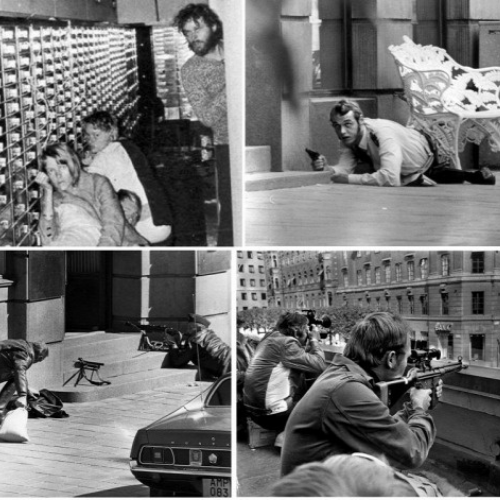Today’s episode is inspired by an article on vox.com from 2017 that I accidentally stumbled on. The title of the article is
I’m an American living in Sweden. Here’s why I came to embrace the higher taxes.
Tom Heberlein writes the article, and I have a link to the full article at the bottom of the show notes.
In the article, he says, “My wife and I have been dividing our time between jobs in Sweden and Wisconsin for the past dozen years, and I’m here to tell you that taxes in Sweden are not that high. To my surprise, I found that there are lots of things to love about the Swedish tax system.”
He then goes on to talk about six different six reasons why he now learned to love the Swedish tax system.
In today’s episode, I will use his six reasons as a starting point to discuss the Swedish taxes, if they are as high as people assume, and look at some of the bigger differences between what you get for your taxes in Sweden compared to the US. I will only look at taxes from an individual perspective, not touching the subject of corporate taxes at all.
This will be a general overview, and I am no expert on tax laws in Sweden or the US. Still, the article got me thinking, and even though I have always felt that everybody always says that Swedes pay so much in taxes, I have never really felt that I had more disposable income here in the US than I had back in Sweden. And Tom Heberlein showed me why it is so in this article.
A fun fact before we take a look at the article, the Swedish word for tax is skatt, which also can be translated as treasure.
Swedish income taxes are not much higher than US taxes — but they give you an education

US critics say that Swedes pay 56 percent — so the government takes over half of your money. This is not true — 56 percent is the marginal tax rate, i.e., what high earners pay on income over a certain amount in both state and local taxes. Only 15 percent of Swedes pay tax at this rate.
So let’s look at the facts of the matter, beginning with taxes for individuals on their income, most Swedes just pay the municipal income taxes. This tax varies depending on the municipality and ranges from 28.98 percent to 35.15 percent.
For the income year 2022, the limit for paying the state income tax is SEK 540,700 ($48,220). You pay state income tax at 20 percent on income above this limit. If you make around SEK 600,000, you pay a 20% tax on the SEK 60,000 above the limit.
Besides these taxes on income, we have a few other taxes for individuals;
For capital gains, the tax rate is generally around 30 percent. If you make a profit on your property sale, the profit is taxed at 22 percent.
Since 2005, there has been no inheritance or gift tax in Sweden, and since 2007, there has been no wealth tax.
Tax forms come already filled out

In Sweden, the four-page tax form comes in the mail already filled out. (…) Seeing they look reasonable, as they always do, we “sign” with a text from our phones. In 15 minutes, we are done.
Most Swedes have confidence in the Swedish Tax Agency, the government agency in charge of collecting taxes and managing the civil registration of private individuals in Sweden.
So who has to declare their taxes in Sweden, and how is it done? The following information is directly copied from the Swedish Tax Agency’s website;
Who must declare?
You must declare if you have received an income declaration sent to you. The declaration comes by post or to your digital mailbox. Sometimes, you must declare even if you have not received a declaration.
This is how you declare if you have not received a form
You who are going to declare but have not received a form can always log in with your e-identification (for example, Bank ID) and declare in the Income Declaration 1 e-service.
The contents of the declaration
Here you will find a description of the content of the declaration 2022. The Tax Agency fills in some information in the declaration, and some information you must fill in yourself.
This is how you declare
You can declare in the Tax Agency app, in the e-service Inkomstdeklaration 1, by texting or calling. You can also declare by submitting the paper form.
Get a tax refund
If you have tax to get back, the money will be deposited into your bank account if you have reported the account number to us. On this page, you will find information about when the tax refund will arrive and how to get it paid.
Payback tax
Your final tax statement shows how much you have to pay and when the money must be deposited into the Swedish Tax Agency’s account. Until then, you can pay the back tax at any time.
Even though I haven’t paid taxes in Sweden for over 20 years now, I remember that I used to go online and submit my declaration of income. Back then, we couldn’t use texting or the app, but we could log in to the website and digitally sign our pre-filled declaration, which in my case, always was correct.
There is no property tax

Property taxes go back to the founding of the United States. They are administered by local governments and most go to pay for schools, local roads, and other services. They range from a high of 2.38 percent in New Jersey to a low of 0.28 percent in Hawaii. (…) in 2006 one of its first steps was abolish the property tax and replace it with a fixed fee.
Property tax was scrapped in Sweden over a decade ago. Property owners pay a much lower fixed fee, equivalent to 0.75 percent of the property’s taxable value but currently capped at 7,412 SEK ($661) each year.
Depending on where you live in the US, this can be quite a lot of money you have to pay.
Sales taxes in Sweden are higher — but less noticeable

Sales taxes are high in Sweden, but you don’t see them, and that makes them easier to pay. If something costs 100 kronor, you pay the 100 kronor! Only when you look at the receipt do you see that it costs 80 kronor and 20 kronor for VAT (value-added tax).
This is the value-added tax (VAT), which in Swedish translates as mervärdesskatt, but is usually called moms.
| Rate | Type | Which goods or services |
| 25% | Standard | All other taxable goods and services |
| 12% | Reduced | Some foodstuffs; non-alcoholic beverages; take away food; minor repair of bicycles, shoes and leather goods, clothing and household linen; hotel accommodation; restaurant and catering services; some works of art, collector’s items and antiques |
| 6% | Reduced | Domestic passenger transport; books (including e-books); newspapers and some periodicals; admission to cultural events (excluding cinema); writers and composers; admission to sports events; use of sports facilities |
| 0% | Zero | Medicines supplied on prescription or sold to hospitals; printing and other services related to the production of magazines for non-profit making organizations; intra-community and international passenger transport |
This was one thing that was difficult to get used to when I first moved here. You have to add the taxes after you add up the cost of what you bought.
We get cash instead of deductions

One of the reasons US income tax preparation is so awful is that we try to reward certain activities by providing a tax deduction. (…) If the Swedish government wants you to do something, they give you the money. For example: Having children is good for the society and costs parents money. In the US, you get a deduction on your income tax for dependents. In Sweden, you get a check every month and you can use it to buy shoes. (…) The process is simple, fair, totally clear, and you don’t have to do anything on your tax form. The money comes when you need it —not a year or more later hidden in a tax refund check.
Of course, the Swedish tax system has its fair share of deductions as well, once again I share information from the Swedish Tax Agency;
When you make a deduction in the return, the income on which your tax is calculated is reduced. This means you will pay less in taxes. How much less your tax will depend on how high your tax is.
And the list is long of all the different deductions you can get, so instead of me just telling you, I link to their website here so you can look for yourself if you are interested. But I think the point he is making is valid. Sweden has made it very easy for people to take advantage of things the tax money is supposed to pay for.
The last point he made in the article will take us into the subject of what you get for your tax money in Sweden.
High taxes give me more choices and freedoms

But tax dollars (…) are used to provide collective goods that are beyond the reach of any individual and that benefit everyone. These collective goods give the middle class more choices, not fewer.
Not having to pay for college gives the best and the brightest the opportunity to attend any school they choose.
(…) hiking trail system (…) like those we take for granted in Stockholm, I get to use it for free and have more choices for hiking.
If this were a suburb of Stockholm (…) of 250,000, there would be train service and bus service several times an hour.
The 33 million Americans who are still not covered by health insurance don’t have much choice when they get sick, unless you think. (…) Paradoxically it turns out the bloated, heavily lobbied, privatized US system spends more tax money ($4,437) per person than Sweden’s socialized health care ($3,184).
I am not burdened by Swedish taxes. In fact, paying more allows me to increase my quality of life in a big way.
So what are the Swedish taxes used for?
Swedish Public Spending can be broken down into six categories. The highest percentage of tax money goes to Social Protection. These numbers are from 2021.
| Characteristics | Percentage |
| Social protection | 31 |
| Public administration | 26 |
| Enterprise and economic development | 13 |
| Health care | 8.5 |
| Education | 7.5 |
| Defense | 5.5 |
| Public order and safety | 5 |
| Recreation, culture and religion | 1.5 |
| Environmental protection | 1.2 |
| Housing and community development | 0.8 |
Social protection includes things like;
“Barnbidrag”: Monetary support for children up to 16 (support also available for older students)
“Föräldrapenning”: Benefits to be able to be home from work to take care of their children for up to 480 days per child. It also includes special benefits to care for sick and disabled children.
“Bostadsbidrag”: Housing allowances for anyone who otherwise can’t afford housing.
“Sjukpenning,” “Sjukersättning,” “Aktivitetsersättning,” and “Handikappersättning”: Benefits if you are ill or disabled and can’t work.
“Arbetslöshetsersättning”: Benefits for unemployed (time limited to 300 days, five days a week, which means 60 weeks)
“Ålderspension,” “Garantipension”: Benefits for those who have retired.
“Försörjningsstöd”: Benefits for anyone (and their children) who otherwise can’t get a reasonable standard of living.
Public Administration is self-explanatory
Enterprise and economic development
Enterprise and industrial policy concerns creating conditions for more jobs and growing companies. The area includes conditions for entrepreneurship and enterprise – such as issues concerning regulatory simplification and supplementary funding and developing and strengthening the innovative capacity of Swedish companies. The area also covers targeted initiatives in various parts of the business sector, state aid, geological and minerals issues, and information initiatives and advisory services to entrepreneurs and business operators.
Health Care
Sweden has a universal health care system. If you are interested in doing a separate episode where I compare the Swedish and the American health systems, let me know by leaving a comment on my website or YouTube.
Education
I discussed this in my episodes about schools, including costs not just for teachers and buildings, students having free school materials, free school lunches, and so forth. Even University is cost-free for Swedes.
Defense
Public order and safety
This includes services like police and fire departments, among many other things,
Recreation, culture, and religion
administration of sporting, recreational and cultural affairs as well as the maintenance of zoos, botanical gardens, public beaches, and parks; support for broadcasting services and, where present, support for religious, fraternal, civic, youth, and other social organizations. Also included are grants to artists and arts companies.
Environmental protection
This includes things like Research to meet social challenges, Fossil-free travel and transport for the climate and environment (including incentives), and initiatives in the area of chemicals to achieve the environmental objective of a toxin-free everyday environment, with a particular focus on children and young people, and initiatives to protect valuable natural environments, including marine areas.
Housing and community development
Housing and community planning are about ensuring the smooth functioning of the housing market and financing of housing. It is also about the planning and design of environments and buildings. This area covers the housing market, surveying – that is, geographic information and property information – and community planning and construction.
Even if it looks, on paper, like every Swede pays an enormous amount of their salaries in taxes, that is not always true. And for those who end up in the marginal tax bracket, the value they get back will make up for the difference in cost compared to the US.
As I said in the beginning, I have never felt that my disposable income is higher here in the US even though I pay less in taxes, there are so many other costs that I have here that I didn’t have in Sweden.
In my next episode, I will talk about how confusing the imperial system is to me and many others that use the metric system.
Until next time
As we say in Sweden
Hej Då!
The Article I’m an American living in Sweden. Here’s why I came to embrace the higher taxes.




